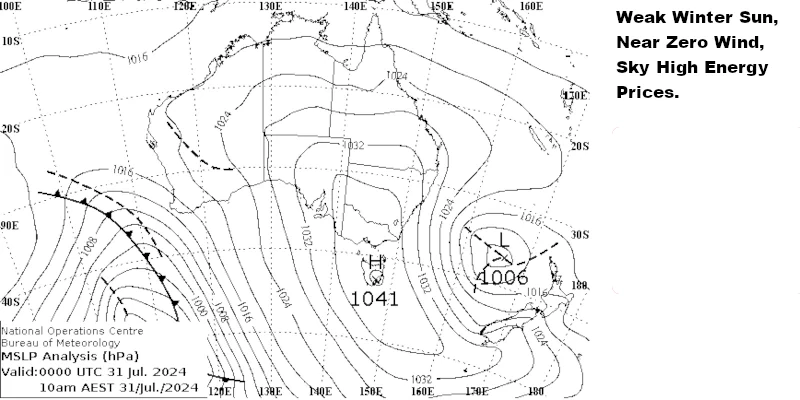
Essay by Eric Worrall
A new study suggests blackouts will only happen sometimes, if we build enough batteries and overcapacity, and a hydrogen export industry.
What is ‘dunkelflaute’? And how will a new long-duration battery change Australia’s energy grid?
Limondale project designed to store excess renewable power during day and dispatch when demand is high
Petra Stock Mon 29 Sep 2025 10.00 AEST
Australia’s longest duration battery will come online this year, a major milestone as the power grid charges towards a mostly renewable energy future.
When fully charged, the Limondale battery in south-west New South Wales will be able to pump 50MW of power back into the grid over eight hours.
…
What is ‘dunkelflaute’ and can we avoid it?
Seasonal, or deep storage (beyond 12 hours), is more like an insurance policy, a strategic reserve for managing rare but unpredictable periods when cloudy and still weather conditions persist over several days.
The phenomenon known as “dunkelflaute” (dark doldrums) is specific to highly renewable grids.
“That’s the bit that is hardest to solve,” Reeve says.
In Australia this risk is low and it can be minimised by the geographic spread of solar, wind and hydro generation, or managed with seasonal storage like pumped hydro, like Snowy 2.0.
…
Read more: https://www.theguardian.com/environment/2025/sep/29/limondale-long-duration-battery-energy-storage-system-bess-what-is-dunkelflaute-energy-grid-nsw-australia
The study which claims the risk of prolonged blackouts is low is model based, they attempt to infer real historical conditions by hind casting based on scraps of historical data.
Quantifying the risk of renewable energy droughts in Australia’s National Electricity Market (NEM) using MERRA-2 weather data☆
Joel Gilmore, Tim Nelson, Tahlia Nolan,
Abstract
It is anticipated that Australia’s National Electricity Market (NEM) will be almost entirely dependent upon variable renewable energy (VRE) production in the coming decades. The Australian Energy Market Operator (AEMO) and other researchers have provided detailed forecasts of the storage and firming required to ensure a secure electricity system that is supplied exclusively by VRE. However, these forecasts utilise existing VRE datasets which are often limited by historical observation given the relatively recent deployment of renewables in the Australian electricity system. This article seeks to significantly expand this analysis by building a VRE output forecast model that utilises 42 years of real-world weather data. This ‘backcasting’ approach provides data that will allow planners to far more accurately determine firming and storage requirements to overcome real-world instantaneous and medium-term production risk in a system supplied entirely by VRE resources. Our results can be used by policy makers to better plan the just transition to a renewable energy-based electricity system.
Read more: https://www.sciencedirect.com/science/article/pii/S0313592625001134
From the body of the study, “… The end goal is a consistent weather dataset with much higher spatial resolution than can be obtained from only physical historical measurements. …”.
The authors claim a high degree of accuracy, and also claim their model avoids overfitting. The following shows one of their model back casts vs real world data.
Personally I have my doubts. Overfitting is an insidious problem with these kinds of back casting attempts, especially when you are dealing with inadequate historical data. Even if you try to keep a portion of the data isolated to test the skill of a model trained on the rest of the data, knowledge of how to overfit that allegedly isolated test data can leak into your model through repeated attempts to get the model right.
The conclusion of the study is interesting;
Through the MERRA-2 reanalysis dataset, we have undertaken a calibrated backcast of the existing VRE fleet as well as a hypothetical Future NEM fleet with greater geographical distribution. While the concept of energy droughts have received much attention, we do not find evidence of extended time periods of low VRE production in the NEM. For example, over a two-week period in the worst historical time sequence, the VRE fleet would still have delivered 70 % of the expected output once seasonal trends (e.g., winter solar production) are taken into account. A 30 % reduction in expected energy is therefore the worst two-week historical VRE drought on record.
…
Firstly, it highlights the amount of firming required. For example, consider the simplest case of flat demand across the year, and the VRE fleet were built such that average generation equalled average demand. Section 4.2 suggests the worst case firming energy requirements would be equal to i) two-thirds of the daily average energy demand; and ii) one-third of average monthly energy demand. This firming could be delivered through conventional hydro, seasonal energy storage, or zero emissions gas peaking units but “overbuilding” the renewable energy fleet (that is, allowing for some spilled energy over time) is also likely to be an efficient source of energy firming. The relatively flat production risk over periods longer than two weeks (Fig. 15) means technologies that can deliver additional energy over longer periods will be favoured (i.e., building additional VRE capacity and fuel based technologies such as zero emission OCGTs). A highly flexible demand side (e.g., hydrogen export industry) will support additional VRE build and provide its own source of firming.
…
Read more: https://www.sciencedirect.com/science/article/pii/S0313592625001134
See – we Aussies can have our glorious renewable future, all we need is to put up with a few more blackouts, create a hydrogen export industry nobody wants, build lots of renewable overcapacity, and provide just over a week (a third of a month) of firming backup capacity, either through gas plants which will sit idle and burn money most of the time, or through lots of batteries.
Looming over all this is the energy surge the AI age is already starting to demand – a possible doubling of current electricity demand by 2050, just through the growth of AI.
Of course for a fraction of the money required to ensure a week of battery backup and 2-3x renewable overcapacity we could refurbish all our coal plants and have near zero blackouts, and not have to bet the farm on a hydrogen export business which does not exist, but that kind of thinking is obviously evil and wrong.



